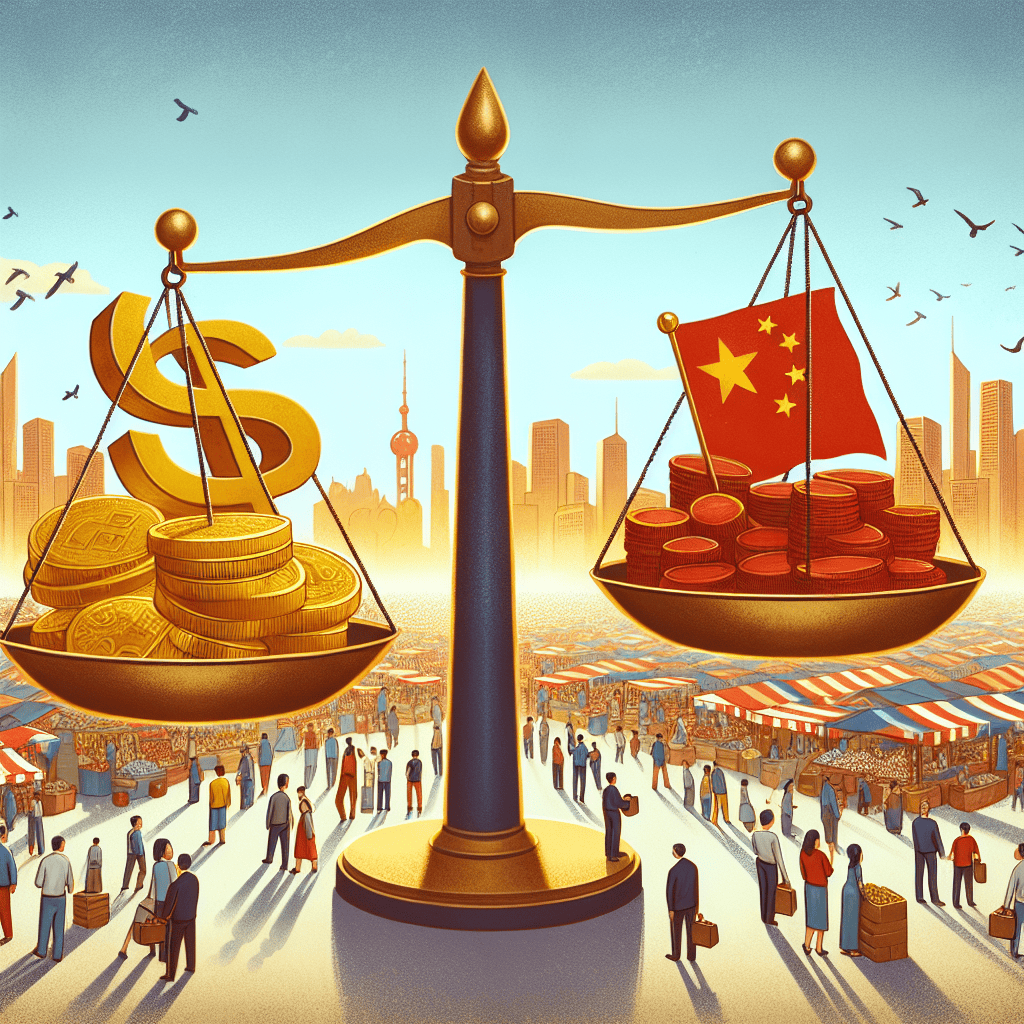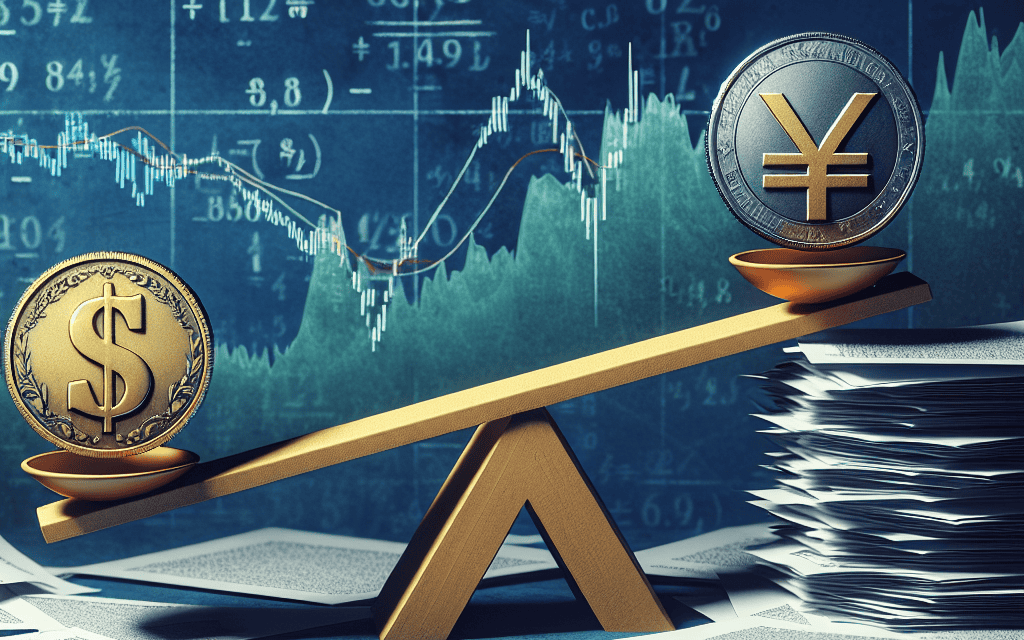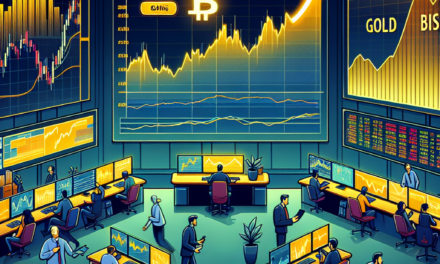“Stability in Uncertainty: Markets Balance China Dynamics and Interest Rate Insights”
Introduction
In recent weeks, global financial markets have demonstrated remarkable resilience, maintaining stability amid a complex landscape shaped by China’s economic developments and ongoing evaluations of interest rate policies by central banks. Investors and analysts are closely monitoring China’s economic indicators, as the world’s second-largest economy navigates challenges such as regulatory shifts and property market fluctuations. Simultaneously, central banks in major economies are assessing interest rate strategies to balance inflationary pressures with economic growth. This dual focus on China and interest rates has created a cautious yet steady market environment, as stakeholders weigh potential risks and opportunities in an interconnected global economy.
Impact Of China’s Economic Policies On Global Markets
In recent months, global markets have demonstrated a remarkable steadiness, even as investors closely monitor developments in China and the ongoing evaluations of interest rates by central banks worldwide. The economic policies of China, the world’s second-largest economy, have long been a focal point for global investors, given their significant impact on international trade and financial markets. As China navigates its economic challenges, including a slowing growth rate and a real estate sector under pressure, its policy decisions are being scrutinized for their potential ripple effects across the globe.
China’s economic policies have historically played a pivotal role in shaping global market dynamics. The country’s recent emphasis on stabilizing its economy through fiscal and monetary measures has been met with cautious optimism by investors. For instance, the People’s Bank of China has implemented targeted interest rate cuts and injected liquidity into the banking system to support growth. These measures aim to bolster domestic consumption and investment, thereby providing a buffer against external economic pressures. Consequently, global markets have responded with a degree of stability, as investors anticipate that these policies will help mitigate the risk of a more pronounced economic slowdown in China.
Moreover, China’s commitment to maintaining a stable yuan has also contributed to market steadiness. By preventing excessive currency fluctuations, China aims to foster a more predictable trading environment, which is crucial for international businesses and investors. This stability in the yuan has been particularly important in the context of ongoing trade tensions and geopolitical uncertainties, as it provides a measure of confidence to global markets that might otherwise be rattled by abrupt currency movements.
Simultaneously, the global financial landscape is being shaped by central banks’ evaluations of interest rates, particularly in major economies such as the United States and the Eurozone. The Federal Reserve and the European Central Bank have been navigating a delicate balance between curbing inflation and supporting economic growth. Their decisions on interest rates are closely watched by investors, as they have far-reaching implications for global capital flows and investment strategies.
In this context, the steadiness of global markets can be attributed to a combination of factors. On one hand, China’s proactive economic policies have provided a degree of reassurance to investors, who are keenly aware of the interconnectedness of global markets. On the other hand, central banks’ cautious approach to interest rate adjustments has helped maintain a stable investment environment, even as inflationary pressures persist.
Furthermore, the resilience of global markets amid these evaluations underscores the adaptability of investors to a complex and evolving economic landscape. While uncertainties remain, particularly regarding the long-term trajectory of China’s economic growth and the potential for further interest rate adjustments, markets have shown an ability to absorb and adapt to these challenges.
In conclusion, the steadiness of global markets in the face of China’s economic policy decisions and interest rate evaluations reflects a nuanced understanding of the current economic environment. Investors are navigating these developments with a focus on long-term stability, recognizing the importance of both China’s economic trajectory and central banks’ monetary policies. As these factors continue to unfold, the global markets’ response will likely remain a key indicator of economic sentiment and investor confidence in the months ahead.
Interest Rate Trends And Their Influence On Market Stability
In recent months, global financial markets have demonstrated a remarkable resilience, maintaining stability despite the dual pressures of China’s economic fluctuations and ongoing evaluations of interest rate policies by central banks. This stability is particularly noteworthy given the complex interplay of factors influencing market dynamics. As investors and analysts closely monitor these developments, understanding the influence of interest rate trends on market stability becomes increasingly crucial.
Interest rates, set by central banks, are a fundamental tool for regulating economic activity. They influence borrowing costs, consumer spending, and investment decisions, thereby impacting overall economic growth. In the current global economic landscape, central banks are navigating a delicate balance between fostering growth and controlling inflation. This balancing act is further complicated by China’s economic performance, which has significant implications for global markets.
China, as the world’s second-largest economy, plays a pivotal role in shaping global economic trends. Recent data indicating a slowdown in China’s economic growth has raised concerns among investors. Factors such as reduced consumer spending, regulatory changes, and geopolitical tensions have contributed to this deceleration. However, despite these challenges, markets have remained relatively stable, suggesting a level of confidence in the ability of central banks to manage potential disruptions.
One reason for this stability is the cautious approach adopted by central banks, particularly the Federal Reserve in the United States and the European Central Bank. These institutions have signaled a commitment to gradual interest rate adjustments, thereby providing markets with a degree of predictability. By clearly communicating their intentions, central banks have helped to mitigate uncertainty, which is often a significant driver of market volatility.
Moreover, the interconnectedness of global markets means that developments in one region can have far-reaching effects. As such, the stability of markets amid China’s economic slowdown and interest rate evaluations can be attributed to a combination of factors. For instance, the diversification of investment portfolios has allowed investors to spread risk across different asset classes and geographic regions. This diversification acts as a buffer against localized economic disruptions, contributing to overall market stability.
Additionally, technological advancements and the proliferation of real-time data have enhanced the ability of investors to make informed decisions. Access to timely information allows for more accurate assessments of market conditions, enabling investors to respond swiftly to changes in interest rate policies or economic indicators. This agility is crucial in maintaining market stability, as it reduces the likelihood of panic-driven sell-offs.
Furthermore, the role of government policies and fiscal measures cannot be overlooked. In response to economic challenges, governments have implemented various stimulus packages and support measures to bolster economic activity. These interventions have provided an additional layer of stability, reassuring markets that authorities are prepared to act decisively to support growth.
In conclusion, the current stability of global markets amid China’s economic fluctuations and interest rate evaluations underscores the complex interplay of factors influencing market dynamics. While challenges remain, the cautious approach of central banks, coupled with diversified investment strategies and timely access to information, has contributed to a resilient market environment. As the global economy continues to evolve, the ability of markets to adapt to changing conditions will be crucial in maintaining this stability.
Analyzing The Resilience Of Markets Amid Global Uncertainties
In recent months, global financial markets have demonstrated remarkable resilience, maintaining stability despite a confluence of uncertainties stemming from China’s economic trajectory and fluctuating interest rate policies. This steadfastness can be attributed to a combination of investor confidence, strategic policy interventions, and adaptive market mechanisms. As investors navigate these complexities, it is crucial to understand the underlying factors that contribute to the markets’ ability to hold steady.
To begin with, China’s economic landscape has been a focal point for global investors, given its significant influence on international trade and investment flows. The country’s recent economic data has presented a mixed picture, with some indicators suggesting a slowdown while others point to potential recovery. For instance, manufacturing output has shown signs of contraction, raising concerns about the ripple effects on global supply chains. However, the Chinese government’s proactive measures, such as fiscal stimulus and monetary easing, have instilled a degree of confidence among investors. These interventions aim to stabilize growth and mitigate the impact of external shocks, thereby providing a buffer against market volatility.
Simultaneously, interest rate evaluations by major central banks have played a pivotal role in shaping market dynamics. The U.S. Federal Reserve, for example, has been closely monitoring inflationary pressures and labor market conditions to determine the appropriate course of action. While the prospect of interest rate hikes has historically triggered market jitters, the Fed’s transparent communication strategy has helped manage investor expectations. By clearly articulating its policy intentions, the central bank has reduced uncertainty, allowing markets to adjust gradually rather than react abruptly to policy shifts.
Moreover, the resilience of markets can also be attributed to the diversification strategies employed by investors. In an environment characterized by uncertainty, diversification across asset classes and geographies has proven to be an effective risk management tool. By spreading investments across equities, bonds, commodities, and alternative assets, investors can mitigate the impact of adverse developments in any single market segment. This approach not only enhances portfolio stability but also provides opportunities for capital appreciation in different economic scenarios.
Furthermore, technological advancements have facilitated more efficient market operations, contributing to their resilience. The proliferation of algorithmic trading and real-time data analytics has enabled market participants to respond swiftly to emerging trends and information. This increased agility allows for more accurate pricing of assets and reduces the likelihood of prolonged market dislocations. Additionally, the rise of digital platforms has democratized access to financial markets, empowering a broader range of investors to participate and contribute to market liquidity.
In conclusion, the ability of global markets to hold steady amid uncertainties related to China’s economic outlook and interest rate evaluations underscores their inherent resilience. This stability is supported by a combination of strategic policy interventions, effective risk management practices, and technological advancements. As investors continue to navigate these challenges, maintaining a balanced perspective and adapting to evolving conditions will be essential. By doing so, they can capitalize on opportunities while safeguarding against potential risks, ensuring that markets remain robust in the face of global uncertainties.
The Role Of Central Banks In Maintaining Market Equilibrium

In the intricate world of global finance, central banks play a pivotal role in maintaining market equilibrium, especially during periods of economic uncertainty. Recent developments, such as China’s economic evaluations and fluctuating interest rates, have underscored the importance of these institutions in stabilizing markets. As investors and policymakers alike navigate these challenges, the actions of central banks become increasingly significant.
Central banks, such as the Federal Reserve in the United States, the European Central Bank, and the People’s Bank of China, are tasked with the dual mandate of fostering economic growth while controlling inflation. This delicate balance is crucial in ensuring that markets remain steady, even when external factors threaten to disrupt the status quo. For instance, China’s recent economic evaluations have raised concerns about the potential ripple effects on global markets. As the world’s second-largest economy, any significant shifts in China’s economic policies or performance can have far-reaching implications. In response, central banks must carefully assess these developments and adjust their monetary policies accordingly to mitigate potential risks.
Interest rates are a primary tool used by central banks to influence economic activity. By adjusting these rates, central banks can either encourage borrowing and investment or rein in excessive spending to control inflation. In the current economic climate, where inflationary pressures are mounting in various parts of the world, central banks face the challenging task of determining the appropriate interest rate levels. This decision-making process is further complicated by the need to consider the economic conditions in major economies like China. As such, central banks must remain vigilant and responsive to changes in the global economic landscape.
Moreover, the interconnectedness of global markets means that the actions of one central bank can have a cascading effect on others. For example, if the Federal Reserve decides to raise interest rates, it could lead to capital outflows from emerging markets as investors seek higher returns in the United States. This, in turn, could prompt central banks in those emerging markets to adjust their own policies to stabilize their economies. Thus, central banks must not only focus on domestic conditions but also consider the broader international context in their decision-making processes.
In addition to interest rate adjustments, central banks employ other tools to maintain market equilibrium. Quantitative easing, for instance, involves the purchase of government securities to increase the money supply and encourage lending and investment. This strategy was widely used during the global financial crisis of 2008 and has been revisited in recent years as economies grapple with the impacts of the COVID-19 pandemic. By injecting liquidity into the financial system, central banks can help to alleviate market stress and support economic recovery.
In conclusion, the role of central banks in maintaining market equilibrium is multifaceted and complex. As they navigate the challenges posed by China’s economic evaluations and interest rate fluctuations, these institutions must employ a range of tools and strategies to ensure stability. By carefully monitoring global economic conditions and adjusting their policies accordingly, central banks can help to foster an environment conducive to sustainable growth and financial stability. As the global economy continues to evolve, the actions of central banks will remain a critical factor in shaping the future of markets worldwide.
Investor Strategies In A Steady Market Environment
In the current financial landscape, investors are navigating a steady market environment characterized by ongoing evaluations of China’s economic policies and interest rate adjustments. This stability presents both opportunities and challenges for investors seeking to optimize their portfolios. As global markets hold steady, it becomes crucial for investors to adopt strategies that are both resilient and adaptable to potential shifts in economic conditions.
To begin with, the economic developments in China play a significant role in shaping global market dynamics. China’s economic policies, particularly those related to trade and industrial output, have far-reaching implications. Investors are closely monitoring these policies, as any significant changes could impact global supply chains and market sentiment. For instance, China’s focus on transitioning to a consumption-driven economy may lead to shifts in demand for commodities and other goods, influencing global prices and investment strategies. Consequently, investors are advised to stay informed about China’s policy directions and consider diversifying their portfolios to mitigate potential risks associated with these changes.
Simultaneously, interest rate evaluations remain a critical factor in the investment landscape. Central banks worldwide are assessing their monetary policies in response to inflationary pressures and economic growth prospects. In this context, the decisions made by major central banks, such as the Federal Reserve in the United States and the European Central Bank, are of paramount importance. These decisions can influence borrowing costs, consumer spending, and overall economic activity, thereby affecting market performance. Investors, therefore, need to be vigilant and prepared to adjust their strategies in response to interest rate changes. For example, in a rising interest rate environment, fixed-income investments may become less attractive, prompting investors to explore alternative asset classes that offer better returns.
Moreover, in a steady market environment, investors should focus on long-term strategies that emphasize diversification and risk management. Diversification remains a fundamental principle of investing, as it helps to spread risk across different asset classes and geographical regions. By diversifying their portfolios, investors can reduce the impact of market volatility and enhance their potential for stable returns. Additionally, incorporating a mix of equities, bonds, and alternative investments can provide a balanced approach that aligns with individual risk tolerance and investment goals.
Furthermore, investors should consider the role of technology and innovation in shaping future market trends. Technological advancements continue to drive significant changes across various industries, creating new investment opportunities. Sectors such as renewable energy, biotechnology, and digital finance are experiencing rapid growth, offering potential for substantial returns. By staying informed about technological developments and identifying emerging trends, investors can position themselves to capitalize on these opportunities.
In conclusion, as markets hold steady amid evaluations of China’s economic policies and interest rate adjustments, investors must adopt strategies that are both informed and flexible. By staying attuned to global economic developments, diversifying their portfolios, and embracing technological innovation, investors can navigate the current market environment with confidence. While challenges remain, the potential for growth and stability exists for those who are prepared to adapt and seize opportunities as they arise. As always, maintaining a disciplined approach and seeking professional financial advice can further enhance investment outcomes in this steady market landscape.
Comparing Market Reactions To Chinese And Western Economic Signals
In recent months, global financial markets have demonstrated remarkable resilience, maintaining a steady course despite the dual pressures of economic signals emanating from China and fluctuating interest rate policies in Western economies. This stability can be attributed to a complex interplay of factors that investors are carefully evaluating to navigate the current economic landscape. As China, the world’s second-largest economy, continues to grapple with its own set of challenges, its economic signals have become a focal point for market participants worldwide. Simultaneously, Western economies, particularly the United States and the European Union, are recalibrating their monetary policies, adding another layer of complexity to the global economic outlook.
China’s economic signals have been mixed, with some indicators pointing to a slowdown while others suggest resilience. The country’s property sector, a significant driver of its economic growth, has shown signs of distress, raising concerns about potential ripple effects on the global economy. However, China’s manufacturing and export sectors have displayed strength, providing a counterbalance to these concerns. Investors are closely monitoring the Chinese government’s policy responses, which have included targeted stimulus measures aimed at stabilizing the economy. These measures have helped to assuage fears of a hard landing, contributing to the overall steadiness of global markets.
In contrast, Western economies are primarily focused on interest rate evaluations as central banks attempt to strike a delicate balance between curbing inflation and supporting economic growth. The U.S. Federal Reserve, for instance, has been navigating a challenging environment characterized by persistent inflationary pressures. Its decisions regarding interest rates are scrutinized by investors, as they have far-reaching implications for global financial markets. Similarly, the European Central Bank faces its own set of challenges, with varying economic conditions across member states complicating its policy decisions. Despite these complexities, markets have remained relatively stable, suggesting that investors have largely priced in the anticipated rate hikes and are prepared for a gradual tightening of monetary policy.
The interplay between Chinese economic signals and Western interest rate policies has created a dynamic environment for investors. On one hand, China’s efforts to stabilize its economy provide a degree of reassurance, while on the other hand, the prospect of rising interest rates in Western economies presents potential headwinds. However, the global economy’s interconnectedness means that developments in one region can have significant implications for others. This interconnectedness has prompted investors to adopt a more nuanced approach, weighing the potential risks and opportunities presented by these divergent economic signals.
Moreover, the resilience of global markets can also be attributed to the diversification strategies employed by investors. By spreading their investments across different asset classes and geographic regions, investors have been able to mitigate some of the risks associated with the current economic environment. This diversification has provided a buffer against potential volatility, allowing markets to maintain a steady course despite the uncertainties.
In conclusion, the steadiness of global markets amid the evaluation of Chinese economic signals and Western interest rate policies underscores the adaptability and resilience of investors. As they continue to navigate this complex landscape, the focus remains on balancing the risks and opportunities presented by these divergent economic signals. While challenges persist, the ability of markets to hold steady reflects a broader confidence in the global economy’s capacity to weather these uncertainties. As such, investors remain vigilant, ready to adjust their strategies in response to evolving economic conditions.
Long-term Implications Of Current Market Stability
The current stability observed in global markets, despite the ongoing evaluations of China’s economic trajectory and interest rate adjustments, presents a fascinating scenario for investors and policymakers alike. This equilibrium, while seemingly precarious, offers a unique opportunity to assess the long-term implications of these factors on the global economic landscape. As we delve into this analysis, it is crucial to consider the interconnectedness of these elements and their potential to shape future market dynamics.
To begin with, China’s economic performance remains a pivotal factor in global market stability. As the world’s second-largest economy, China’s growth rates and policy decisions have far-reaching implications. Recent data suggests a moderate slowdown in China’s economic expansion, attributed to both domestic challenges and external pressures. However, the Chinese government’s commitment to implementing structural reforms and stimulating domestic consumption provides a counterbalance to these concerns. Consequently, global markets have responded with cautious optimism, maintaining stability as investors await further clarity on China’s economic policies.
Simultaneously, interest rate evaluations by major central banks, particularly the Federal Reserve, play a critical role in shaping market sentiment. The ongoing debate over the timing and magnitude of interest rate adjustments has kept investors on edge. While some advocate for a more aggressive approach to curb inflationary pressures, others caution against potential disruptions to economic growth. The Federal Reserve’s recent decision to maintain a measured pace in adjusting interest rates has contributed to the current market stability, as it signals a commitment to balancing growth and inflation concerns.
Moreover, the interplay between China’s economic outlook and interest rate policies underscores the complexity of the global economic environment. On one hand, a stable Chinese economy can mitigate the impact of interest rate hikes by providing a steady demand for global goods and services. On the other hand, significant shifts in interest rates could influence capital flows, potentially affecting China’s economic performance. This intricate relationship highlights the importance of coordinated policy efforts to sustain market stability in the long term.
In addition to these primary factors, other elements such as geopolitical tensions, technological advancements, and environmental considerations also contribute to the broader market landscape. Geopolitical developments, particularly in regions with significant economic influence, can introduce volatility and uncertainty. Meanwhile, technological innovations continue to reshape industries, offering both opportunities and challenges for market participants. Furthermore, the growing emphasis on sustainability and environmental responsibility is increasingly influencing investment decisions, adding another layer of complexity to market dynamics.
As we consider the long-term implications of the current market stability, it is essential to recognize the potential for both opportunities and risks. On one hand, sustained stability can foster an environment conducive to investment and economic growth, encouraging businesses to expand and innovate. On the other hand, complacency in the face of underlying challenges could lead to unforeseen disruptions. Therefore, it is imperative for investors and policymakers to remain vigilant, continuously assessing the evolving landscape and adapting strategies accordingly.
In conclusion, the current stability in global markets, amid evaluations of China’s economic trajectory and interest rate policies, presents a multifaceted scenario with significant long-term implications. By understanding the interconnectedness of these factors and considering additional influences, stakeholders can better navigate the complexities of the global economic environment. As we move forward, maintaining a balanced approach that prioritizes both growth and stability will be crucial in ensuring sustained market resilience.
Q&A
1. **Question:** What factors are contributing to the markets holding steady?
**Answer:** Markets are holding steady due to evaluations of China’s economic situation and interest rate decisions by central banks.
2. **Question:** How is China’s economic situation impacting global markets?
**Answer:** China’s economic situation, including its growth rates and policy decisions, is influencing investor sentiment and market stability globally.
3. **Question:** What role do interest rates play in market stability?
**Answer:** Interest rates affect borrowing costs, consumer spending, and investment, thereby influencing market stability and investor confidence.
4. **Question:** Are there any specific sectors benefiting from the current market conditions?
**Answer:** Sectors such as technology and consumer goods may benefit from stable interest rates and steady economic conditions.
5. **Question:** How are investors reacting to the current market evaluations?
**Answer:** Investors are cautiously optimistic, balancing potential risks from China and interest rate changes with opportunities for growth.
6. **Question:** What are central banks doing in response to these evaluations?
**Answer:** Central banks are closely monitoring economic indicators and may adjust interest rates to maintain economic stability.
7. **Question:** What is the outlook for markets in the near future?
**Answer:** The outlook remains cautiously positive, with markets expected to remain steady as long as there are no significant negative developments in China or unexpected interest rate hikes.
Conclusion
The markets have demonstrated resilience, maintaining stability despite ongoing evaluations of China’s economic conditions and interest rate fluctuations. Investors appear to be cautiously optimistic, balancing concerns over China’s economic slowdown and potential policy shifts with the anticipation of central banks’ interest rate decisions. This equilibrium suggests that while uncertainties remain, market participants are adapting to the evolving global economic landscape, reflecting a measured confidence in the ability to navigate these challenges.





